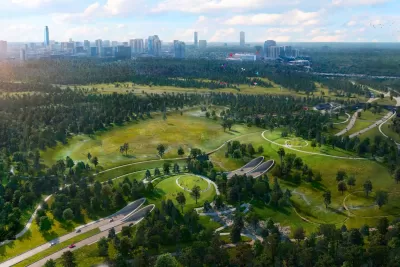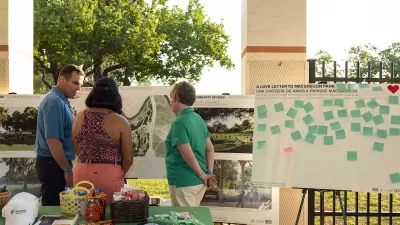The Houston Chronicle editorial board calls the newly redesigned park a “transformative” project, urging state transportation officials to take note.

The Houston Chronicle editorial board writes in praise of the transformative Memorial Park redesign, led by landscape architect Thomas Woltz of Nelson Byrd Woltz.
The 2015 master plan for the park, whose location has been the site of a series of important historical events, is the result of years of work that culminated in the relocation of a roadway and the construction of a $70 million land bridge. The design pays homage to the history of Camp Logan, a former World War I training facility where Black soldiers were killed after marching against abuse, though the board notes that “we'd like to see more signage to mark the history, and educate curious visitors about it.”
The editorial acknowledges the project’s critics, such as Susan Chadwick, leader of a group called Save Buffalo Bayou, who says the plan was a “vanity project” that altered the environment too much. The board disagrees, writing that, although they took issue with tax increment reinvestment zones (TIRZs) as a source of funding, “the transformation of Memorial Park is a remarkable public good.”
The board doesn't ignore the park's position as an ostensibly natural space in the middle of a vast metropolis.
“Woltz's team attempted to frame as picturesque a view as possible, but standing atop the land bridge tomorrow's picnic goers will still sense that they are in the middle of infrastructure — that big parks in Houston are also about building parking lots, that highways are also about flood management, that flood management is about parks and housing.”
Despite its limitations, the editorial board sees the Memorial Park project as a model for the Texas Department of Transportation (TxDOT), which has not factored green space or parks into its budget for rebuilding Interstate 45. “The Memorial Park master plan started off with wildlife connectivity, human connectivity, improved the human experience and public access.” In the opinion of the board, other major infrastructure projects should take the same approach.
FULL STORY: What Memorial Park can teach Texas' highway department (Editorial)

Maui's Vacation Rental Debate Turns Ugly
Verbal attacks, misinformation campaigns and fistfights plague a high-stakes debate to convert thousands of vacation rentals into long-term housing.

Planetizen Federal Action Tracker
A weekly monitor of how Trump’s orders and actions are impacting planners and planning in America.

San Francisco Suspends Traffic Calming Amidst Record Deaths
Citing “a challenging fiscal landscape,” the city will cease the program on the heels of 42 traffic deaths, including 24 pedestrians.

Defunct Pittsburgh Power Plant to Become Residential Tower
A decommissioned steam heat plant will be redeveloped into almost 100 affordable housing units.

Trump Prompts Restructuring of Transportation Research Board in “Unprecedented Overreach”
The TRB has eliminated more than half of its committees including those focused on climate, equity, and cities.

Amtrak Rolls Out New Orleans to Alabama “Mardi Gras” Train
The new service will operate morning and evening departures between Mobile and New Orleans.
Urban Design for Planners 1: Software Tools
This six-course series explores essential urban design concepts using open source software and equips planners with the tools they need to participate fully in the urban design process.
Planning for Universal Design
Learn the tools for implementing Universal Design in planning regulations.
Heyer Gruel & Associates PA
JM Goldson LLC
Custer County Colorado
City of Camden Redevelopment Agency
City of Astoria
Transportation Research & Education Center (TREC) at Portland State University
Jefferson Parish Government
Camden Redevelopment Agency
City of Claremont





























